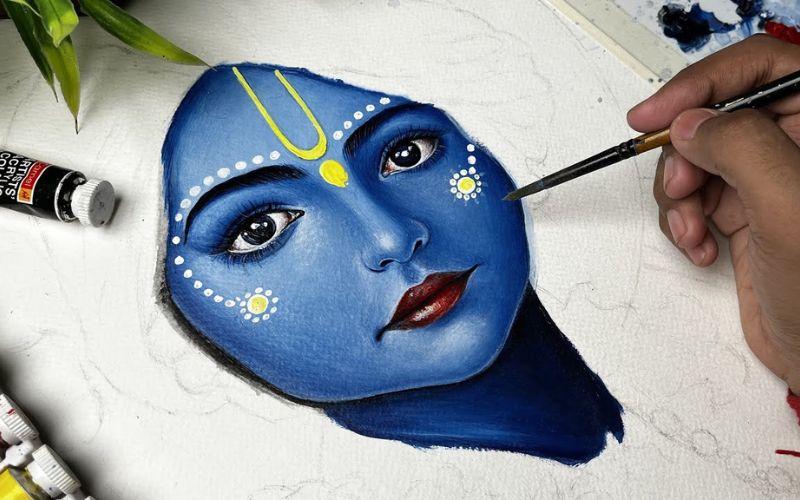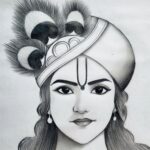Painting as an art form has always served as a powerful medium to express emotions, tell stories, and convey profound spiritual messages. Among the numerous subjects that have captivated artists over the centuries, the depiction of Lord Krishna stands out for its deep cultural, religious, and aesthetic significance. Krishna, a central figure in Hinduism, is revered not only as a deity but also as a symbol of love, compassion, and wisdom. The painting of Krishna has transcended time and geography, evolving in style and interpretation while maintaining its spiritual essence. In this article, we will explore the rich tradition of Krishna paintings, examining their historical context, various styles, and the enduring appeal of this divine subject.
Historical Context of Krishna in Art
Krishna, one of the most beloved deities in Hinduism, has been the subject of countless works of art over millennia. His life and teachings, as chronicled in texts like the Mahabharata, the Bhagavad Gita, and the Srimad Bhagavatam, offer a rich tapestry of stories that have inspired artists. From his playful childhood in Vrindavan to his role as the charioteer and guide in the Mahabharata, Krishna’s multifaceted personality has provided endless material for artistic exploration.
The earliest depictions of Krishna can be traced back to ancient Indian sculptures and frescoes. However, it was during the medieval period that Krishna’s portrayal in paintings began to flourish. The Bhakti movement, which emphasized personal devotion to deities, played a significant role in popularizing Krishna as a subject of art. As devotional practices spread across India, so did the artistic representations of Krishna, each region adding its unique stylistic interpretation.
Evolution of Krishna Painting Styles
The depiction of Krishna in painting has undergone significant evolution over the centuries, with various schools of art contributing to the rich diversity of styles. These styles not only reflect the regional and cultural influences but also the personal devotion of the artists.
- Mughal Influence on Krishna Art The Mughal Empire, which ruled much of India from the 16th to the 19th century, had a profound impact on Indian art. While the Mughals were predominantly Muslim, their patronage of the arts led to a fusion of Persian and Indian styles, known as Mughal painting. Krishna, despite being a Hindu deity, found his way into Mughal art due to the inclusive nature of the empire’s artistic pursuits.Mughal paintings of Krishna often portrayed him in a regal manner, with intricate details and luxurious settings. These paintings were characterized by their delicate brushwork, attention to detail, and the use of rich colors. The influence of Persian miniature painting is evident in the Mughal depictions of Krishna, where the emphasis was on refinement and elegance.
- Pahari Painting The Pahari school of painting, which emerged in the hilly regions of North India (Himachal Pradesh, Jammu, and parts of Punjab) during the 17th to 19th centuries, is known for its lyrical and romantic portrayal of Krishna. The Pahari artists were deeply influenced by the Bhakti movement, and their works often depicted the divine love between Krishna and Radha, his eternal consort.Pahari paintings are characterized by their vibrant colors, intricate details, and the use of natural landscapes. Krishna is often depicted as a youthful, charming figure, playing the flute amidst lush gardens and groves. The Radha-Krishna theme dominates Pahari art, with the emphasis on the emotional and spiritual bond between the two.
- Rajasthani and Mewar Schools The Rajasthani school of painting, particularly the Mewar school, is another significant contributor to the tradition of Krishna paintings. Emerging in the 17th century, Rajasthani paintings are known for their bold colors, stylized forms, and strong emphasis on narrative.In Mewar paintings, Krishna is often depicted as a heroic figure, engaging in various divine pastimes (lilas) such as lifting the Govardhan Hill or performing the Rasa dance with the Gopis (cowherd maidens). The Mewar artists also focused on Krishna’s role as a protector and guide, portraying scenes from the Mahabharata and the Bhagavad Gita.
- Bengal School of Art The Bengal School of Art, which emerged in the late 19th and early 20th centuries, played a pivotal role in the revival of Indian art during the British colonial period. Under the guidance of artists like Abanindranath Tagore, the Bengal School sought to return to the spiritual and cultural roots of Indian art, moving away from Western influences.Krishna paintings from the Bengal School are marked by their emphasis on spirituality, emotion, and a return to traditional Indian aesthetics. The use of soft, flowing lines, muted colors, and a focus on the divine aspects of Krishna are characteristic of this style. The Bengal School’s depictions of Krishna often highlight his role as a divine lover and a symbol of universal love.
- Contemporary Interpretations In contemporary times, the depiction of Krishna has taken on new forms and interpretations, reflecting the changing cultural and social landscape. Modern artists have experimented with various styles, from abstract to surreal, while still drawing inspiration from the traditional themes associated with Krishna.Contemporary Krishna paintings often explore the deity’s symbolism, using bold colors, unconventional forms, and innovative techniques. While the traditional themes of love, devotion, and divinity remain central, modern artists also address contemporary issues such as the environment, social justice, and the intersection of spirituality and modernity.
Symbolism and Themes in Krishna Paintings
The paintings of Krishna are rich in symbolism, with each element carrying deep spiritual and cultural meanings. Understanding these symbols is essential to fully appreciating the art form.
- The Flute One of the most iconic symbols associated with Krishna is the flute. In paintings, Krishna is often depicted playing the flute, an act that symbolizes divine music that calls the soul towards the spiritual realm. The flute also represents the hollow, egoless state required to receive divine grace. The sound of Krishna’s flute is said to have a magnetic quality, drawing all beings towards him, symbolizing the universal attraction of the divine.
- Peacock Feather The peacock feather adorning Krishna’s crown is another significant symbol. The peacock, with its vibrant colors, represents beauty, grace, and purity. In the context of Krishna, the peacock feather symbolizes his connection with nature and the divine play (lila) in which he engages with the world. The feather also serves as a reminder of the need for spiritual upliftment, rising above worldly concerns.
- Radha-Krishna The depiction of Radha and Krishna together is a central theme in many paintings. Radha represents the individual soul (jiva) and Krishna, the supreme soul (Paramatma). Their divine love is symbolic of the eternal bond between the soul and God. Radha’s longing for Krishna and their union represent the soul’s journey towards spiritual realization and ultimate union with the divine.
- Govardhan Hill The scene of Krishna lifting the Govardhan Hill is a popular subject in many paintings. This act symbolizes Krishna’s role as a protector and sustainer of the world. The lifting of the hill is also symbolic of the triumph of faith over doubt and the importance of seeking refuge in the divine during times of adversity.
- Rasa Lila The Rasa Lila, the divine dance of Krishna with the Gopis, is another recurring theme in Krishna paintings. This dance is symbolic of the cosmic play of creation, where the divine engages with the souls in a dance of love and devotion. Each Gopi represents a soul, and their dance with Krishna symbolizes the blissful union with the divine.
The Enduring Appeal of Krishna Paintings
The painting of Krishna continues to captivate artists and art lovers alike, transcending time and cultural boundaries. Several factors contribute to the enduring appeal of Krishna as a subject in art.
- Spiritual Significance Krishna’s life and teachings hold deep spiritual significance, making him a revered figure in Hinduism. His depiction in art serves as a visual representation of spiritual ideals, inspiring devotion and contemplation. The various forms of Krishna, from the playful child to the wise charioteer, offer a rich palette of emotions and qualities for artists to explore.
- Cultural Resonance Krishna is not just a religious figure but also a cultural icon. His stories and teachings have permeated various aspects of Indian culture, from literature and music to dance and theater. The depiction of Krishna in art resonates with people across different regions and traditions, making him a unifying figure in the cultural fabric of India.
- Artistic Inspiration The multifaceted nature of Krishna’s persona offers endless possibilities for artistic expression. Whether it is the delicate beauty of Radha-Krishna’s love, the heroic feats of Krishna as a protector, or the mystical symbolism of his divine play, artists find in Krishna a subject that allows for creativity and innovation.
- Timeless Themes The themes associated with Krishna, such as love, devotion, sacrifice, and the interplay between the divine and the human, are timeless and universal. These themes continue to resonate with people across different cultures and eras, making Krishna paintings relevant even in contemporary times.
- Aesthetic Appeal The visual appeal of Krishna, with his youthful charm, vibrant colors, and graceful forms, adds to the attraction of his depiction in art. The aesthetic beauty of Krishna paintings, combined with their spiritual depth, makes them a cherished form of art in both religious and secular contexts.
Conclusion
Painting Krishna is more than just an artistic endeavor; it is a spiritual journey that connects the artist and the viewer to the divine. The rich tradition of Krishna paintings



